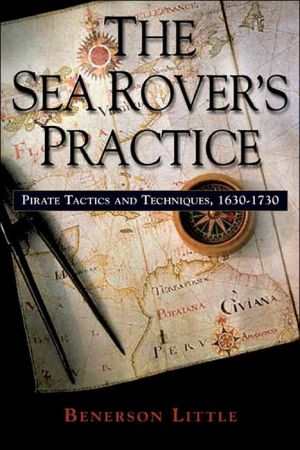

 |

|

The average rating for The Sea Rover's Practice: Pirate Tactics and Techniques, 1630?1730 based on 2 reviews is 3.5 stars.
Review # 1 was written on 2013-11-10 00:00:00 Oliver Merrick Oliver MerrickThe Sea Rover's Practice is one of the most phenomenal pieces of enthusiast history, if not one of the most engaging history books, that I've ever read. This book is near the top of the small list of pirate non-fiction literature; for anyone with an interest in the era, Little is required reading along with Exquemelin, Johnson, and Cordingly. The best part of the book is how well-researched it is. There are footnotes, numerous appendices, and hardly a paragraph passes without an excerpt from a fascinating first-hand source. The Sea Rover's Practice is crammed with 1001 delicious factoids. The only downside is that the prose can be workmanlike. Some chapters are harder to get through than others. I found my eyes glazing over far too often for such engaging material. Even with all his enthusiasm, Little can be a little dull. Here are but two random samplings of the treasure trove of 'fun facts' on offer within The Sea Rover's Practice: The simple act of leaping from one ship to another was dangerous, not only because of enemy fire, but because the two ships were working board and board. Duguay-Trouin was stunned during his first boarding action when the ship's master fell between the two vessels and was crushed, part of his brains splattering the young officer. This gruesome death gave Duguay-Trouin pause, as he had not yet found his sea legs and wondered if he could get across without being similarly crushed. The French eventually took their prize "sword in hand" after three consecutive boardings. ... Besides drink there was food, fresh and cooked well, a relief from a ship's rations. In the West Indies turtle flesh was a common cure for everything, and although plentiful in the region, it was so very popular that it was even imported from the Canary Islands. Turtle liver was "very wholesale, searching and purging," and such purging was necessary. Between the diet of salt flesh and hard liquor at sea and the diet of fatty flesh, far too much hard liquor, and sexually transmitted diseases ashore, the sea might have been the healthier environment of the two. Besides the qualities of turtle liver, turtle oil was believed good for strains and muscle aches, and the flesh was not only a good antiscorbutic but also an "Antivenereal Diet." For what it's worth, eating the liver dyed one's stool black, and the fat turned urine sea green. |
Review # 2 was written on 2009-02-09 00:00:00 James Hernandez James HernandezWhen I was younger, I spent endless hours in the history sections of college library browsing through the history books looking for concrete lists of facts, numbers, measurements, parts, names, and well lists that I could gather and utilize in my role playing games. Every such book was viewed through a lens of how much data it could provide to my simulations, and with few exceptions most were judged unworthy being filled with dry stories and no concrete facts. Now though, it seems every historian out there is ready to cater to my earlier needs. Facts are collected and drawn up in tidy little lists, and everything is categorized and laid out in logical sections as if ready to draw up the requirements or setting encyclopedia for the latest wargame or RPG. And naturally, far from content, I find myself missing history that was stories and contained long direct quotes from the real life characters. So it is with this book. I'd have loved 25 years ago. It's still an excellent introduction to the subject matter, and might be a decent 'sophomore text book' on the Age of Piracy. But as History, it needs more story in it, and a bit more history rather than just a study and summary of history, however well organized it is. I found myself yearning for the actual journals that were the author's source material, and wished for more direct views into their contents. Most of all, I would have preferred more detail about how it was actually done, with examples. It's all well and good to say that the Pirates preferred an ambush, but how was that actually accomplished on the open sea with boats that would sail 3mph or so in a fair wind? What customary behavior might ships have had that allowed a nare-do-well to cozen his prey into close range? We glimpse the scene I think too dimly, and with too little information. The only hints we are given are brief mentions of flying false colors and hiding your crew below decks so as to seem more harmless than you are, but I think that's probably only a taste of a broad range of aiming to misbehave. |
CAN'T FIND WHAT YOU'RE LOOKING FOR? CLICK HERE!!!